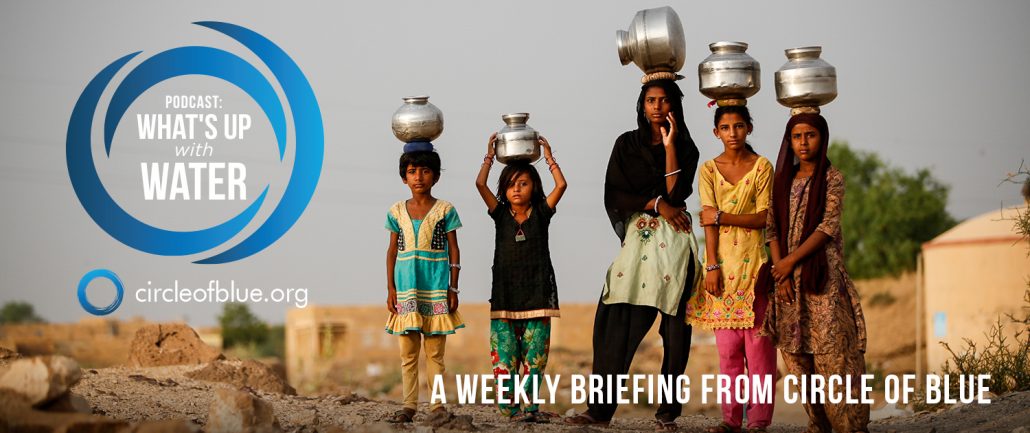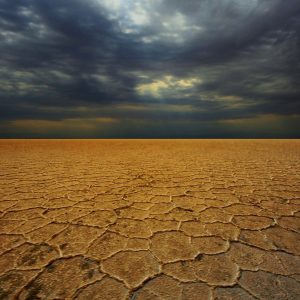
Transcripts
What’s Up With Water – July 9, 2018
I’m Eileen Wray-McCann, for Circle of Blue, and here’s What’s up
with Water, your “need-to-know news” of the world’s water.
Demonstrators in southwestern Iran who were protesting water
shortages and pollution clashed with security forces earlier this
month. 11 people were injured in the protests in
Khuzestan province, near the Iraq border when an unidentified man
began shooting.
The state-run news agency acknowledged that there have been a
number of demonstrations over water quality in cities in Khuzestan. A large part of the province’s agricultural sector
reportedly lacks irrigation water.
Khuzestan was hard hit by the eight-year war with
Iraq in the 1980s. Drought and pollution have been persistent
problems for the primarily Arab residents, who accuse officials of
discrimination. Water shortages, however, are widespread, and
protests continue across Iran.
The Financial Tribune of Tehran says that about 40 per cent of Iran
has endured “serious drought” since last December. A government
monitoring agency said that the last four months of 2017 were the
driest period in the last 67 years, with rainfall amounts reduced to
less than half the long-term average.
The head of Iran’s Civil Defense Organization recently accused Israel
of causing drought in his country by extracting water out of clouds
over the Mediterranean. By the time they reached Iran, he said, they
were too dry to bring needed rain or snow. A director of Iran’s
weather agency dismissed the charge, warning that such talk would
distract from the country’s real problems.
A new report from the European Environment Agency says that most
of Europe’s waterways are failing water quality tests.
The State of Our Waters report summarizes data from 130 thousand
water bodies in Europe. It concludes that only 40 per cent of the
surveyed lakes, rivers and streams are in good ecological condition.
The other 60 per cent do not meet minimum standards for avoiding
pollution and habitat degradation. That’s despite EU laws and
biodiversity efforts.
The report indicated that England is one of the poorest performers.
Scotland showed far better results, with water standards comparable
to Scandinavia.
The report’s data showed a major contrast between chemical
pollution in ground and surface water sites. Good quality groundwater
sites were twice as prevalent as good quality surface water sites.
Mercury is one of the most common pollutants, along with pesticides,
wastewater, and contaminated rainfall.
The head of natural resources for the World Wildlife Fund in Europe
told the Guardian that “the legislation is there in the form of the EU’s
Water Framework Directive, but the political will is clearly lacking to
make it work on the ground.”
Summer in the United States comes with increasing concern over
algae blooms in major waterways. In the Great Lakes region, early
and intense summer heat brought early blooms in the western part of
Lake Erie, along with concerns for health and drinking water safety.
Meanwhile, Florida’s coasts face a threat from Lake Okeechobee,
which is swamped with a massive algae bloom that is oozing through
waterways both east and west.
In the Great Lakes, officials are warning residents to avoid all scums
floating on western Lake Erie, as intense summer temperatures have
prompted early algae growth. Lake Erie has a couple hundred types
of algae, and most of these are harmless parts of the food chain. But
cyanobacteria are different. They look like algae but are actually
bacteria that produce toxins and thrive in warm water.
Lake Erie toxin levels are not yet clear, and the blooms are in the
early stages of their growth, moving around as the wind blows them.
But they have been large enough to be monitored by satellite. And
they are growing faster and getting denser.
A University of Toledo algae researcher says the blooms typically
form around Toledo first because the water is shallower, and
therefore warmer. He says that this early bloom could be the main
one that continues until October. In the past, early “mini blooms” form
and die off before the main blooms come later in the summer.
But he says this year, the heat may mean no break.
In 2014, Toledo’s water intake was hit by a toxic algae bloom,
creating a citywide water crisis. So far, the water intake is not in
danger, but the National Oceanic and Atmospheric Administration
has been looking for a sizeable bloom in 2018. NOAA will issue its
final forecast for this year on July 12.
In Florida’s Lake Okeechobee, bright green algae form mats that are
many inches thick. They can seriously impair ecosystems, kill fish,
and destroy oyster populations and sea grasses. And they can be
harmful to humans and animals. Florida has been testing affected
waters for toxic cyanobacteria, and has so far reported only low
amounts. However, a local river watch group recently posted its own
testing, which showed that some of the worst blooms were hundreds
of times over safety limits.
The spread of algae could have wide implications from politics to
business. Governor Rick Scott has a history of defunding Florida’s
environmental regulators. He has ordered emergency efforts to
contain the algae outbreak, which could be an issue in his campaign
for the U.S. senate. The U.S. Army Corps of Engineers plans to cut
back water flows to Florida’s eastern coast in order to give the tides a
chance to flush the algae, but it warns that summer rains will force
additional water releases.
Environmentalists have long urged more monitoring and protection
for Florida’s water. They say that state has failed to get to the heart of
the bloom problem: excessive nutrients from agricultural runoff, urban
stormwater, and leaking septic tanks.
The state has tried for decades to clean Lake Okeechobee, creating
filter marshes and attempting to enforce runoff rules. But the lake has
been inundated with nutrients, and both tropical storms and seasonal
rains can have a major effect on the distribution and movements of
those nutrients.
Residents at Lake Okeechobee are pressing for a new management
plan. A huge reservoir to divert water is at least seven years away.
For now, the district struggles with temporary measures to get the
water moving without spreading the algae mess along the coasts.
Weather is crucial, and though less rain is predicted over the next two
weeks, the rainy season overall is expected to be wetter than usual.
As Lake Okeechobee fills, its water, and its algae, will need
somewhere to go.
Most of Ireland is in a state of “absolute drought,” according to the
Irish Times. For the last two weeks, no rainfall was recorded at 24 of
25 weather stations. The whole country is under a hosepipe ban,
which prohibits the use of water for gardening, car washing or filling
pools. Irish Water says the ban may be in effect through July, as dry,
warm weather is predicted well into this week.
And that’s What’s Up With Water…We’d like you to share what’s up
where you are – Tweet us with your water news: @circleofblue #whatsupwithwater.
Eileen Wray-McCann is a writer, director and narrator who co-founded Circle of Blue. During her 13 years at Interlochen Public Radio, a National Public Radio affiliate in Northern Michigan, Eileen produced and hosted regional and national programming. She’s won Telly Awards for her scriptwriting and documentary work, and her work with Circle of Blue follows many years of independent multimedia journalistic projects and a life-long love of the Great Lakes. She holds a BA and MA radio and television from the University of Detroit. Eileen is currently moonlighting as an audio archivist and enjoys traveling through time via sound.





